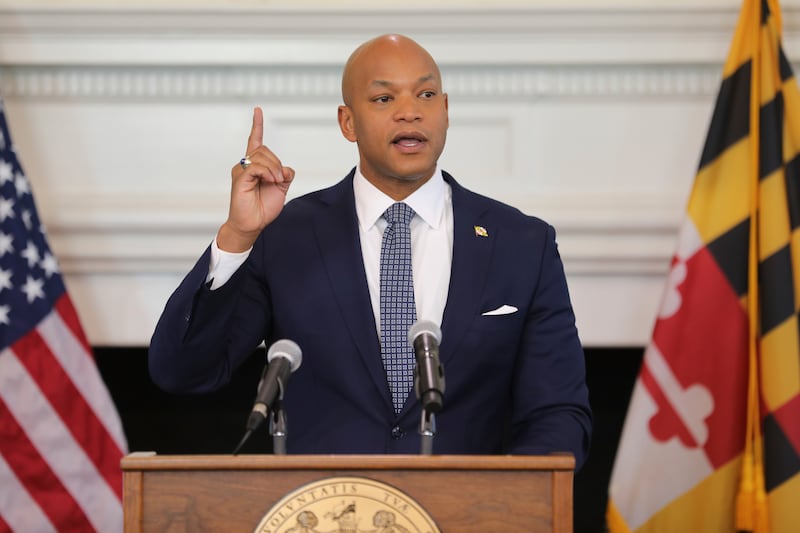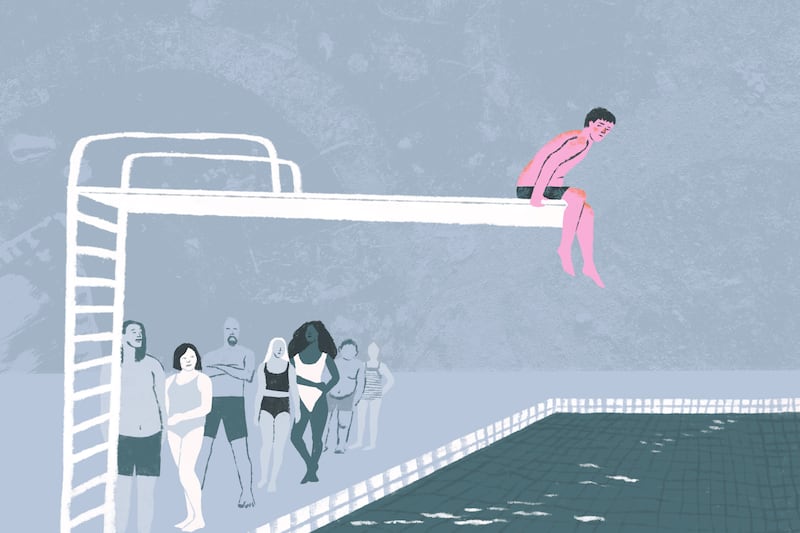Emanuel Barcenas told NBC News he’s applied for 900 jobs — which seems like a lot, until you compare him to Zach Taylor, who told The New York Times he’s applied for more than 5,700.
Both men are 25 years old and college graduates, which sets them apart from many of their peers, since the number of American men going to college has been steadily shrinking. But their stories are part of a larger problem: Too many of America’s young men are struggling in ways that their fathers and grandfathers didn’t in generations past.
Unemployment among young men is rising, in large part because of a changing job market, made even more uncertain by the rapid growth of artificial intelligence. Some, growing discouraged, are becoming part of a group called NEETs — which stands for “not in employment, education or training.”
Loneliness and suicide among young men are rising — young men are now more at risk of suicide than middle-aged men. Many want a family, but nearly half aren’t dating. They are living with their parents longer, and despair of being able to afford a house and provide for a family. They are being written off, even scorned, by young women, whose political leanings are often different from their own.
And their increasing isolation is part of a wider societal trend accelerated by COVID-19: All Americans are less likely to leave their house for entertainment and dining, and even to go to a job or to church.
But there are rumblings of hope coming from an unlikely place: the world of politics.
After years of the “boy crisis” being discussed in academia and social science, it’s becoming a priority for governors — among them, Utah’s Spencer Cox, California’s Gavin Newsom and Maryland’s Wes Moore.
“Could the suddenly everywhere ‘boy troubles’ become a surprise political issue for the midterms?” Richard Whitmire, the author of the 2010 book “Why Boys Fail,” recently asked on social media.
“That’s my prediction,” Whitmire added. “The fun part: Either party could seize it.”
While politicization of any issue is not often seen as a good thing, in this case, it might be, Whitmire said in an interview. He has long been a proponent of sweeping changes in education to help boys become more proficient at reading at an earlier age, and he wants to see a courageous politician take up that banner.
Other solutions being proposed across the country include programs to get more young men in higher education and apprenticeships, providing more role models and mentors for boys, expanding mental health supports, and curbing the amount of time that boys and teens spend online in addictive and destructive behavior.
These initiatives are being developed with the understanding that success is not a zero-sum game — no one wants to erase the gains that girls and women have made, both in education and the workplace, as Newsom said in his recent executive order on supporting boys and men. But there is a new bipartisan consensus that boys and men need attention.

In February of 2012, the Deseret News published a deep dive on the “War on Boys,” examining how young men were losing ground in education, health and jobs. There is a straight line that leads from that “boy crisis” to what’s been called a “masculinity crisis” plaguing young men today.
The good news is, suddenly lots of hands are coming on deck. And one reason is the reelection of President Donald Trump, an event that has caused soul-searching in the Democratic Party about what is happening with America’s young men.
From pointing fingers to helping hands
Whitmire, writing recently for the education website The74million.org, said the issue is “the plumpest political opportunity you could imagine,” one that is ripe to engage parents.
In the piece, he noted that Virginia Gov. Glenn Youngkin got elected in 2021 by “by stirring up parents in places such as prosperous Loudoun County over discipline, masking and transgender students’ bathroom and locker room use. That’s small potatoes compared to the broader boy problems,” he wrote.
Those broader problems include the number of men living with their parents in adulthood; an increase in the number of men who say they don’t have a close friend; and a higher rate of unemployment than women, even among men who have college degrees. Men with college degrees now have roughly the same unemployment rate as men who don’t.
In school, girls perform better than boys across many academic measures; boys are more likely to get suspended. And 47% of young women hold college degrees compared to 37% of men.
Speaking at the Deseret News three years ago, Richard Reeves, founder and president of the American Institute for Boys and Men, said, “There’s a lot of fingers being wagged at young boys and men, but not many helping hands being extended.”
But in an interview last week, Reeves said “the ground is really shifting quite quickly” in this space, and in promising ways.
For one thing, he said that the governors getting involved in the issue — including Michigan’s Gretchen Whitmer — are doing so in a serious way.
“In each case, they’ve clearly decided that these are serious issues and they should govern on them, rather than just podcast on them. ... It hasn’t felt like a culture-war move,” Reeves said.
While Gavin Newsom did, in fact, focus on the issue on his podcast on the same day that he issued an executive order to take steps to help men, Reeves said he is encouraged by a “seriousness of intent around this issue, which was reflected in the news coverage, which was respectful, not sensational, and focused on solutions.
“They didn’t try to win a news cycle with this stuff. And for me, that’s incredibly important and incredibly encouraging,” Reeves said.
“I want to spend less time talking about whither masculinity and what does it mean for politics and the cultural stuff and what do you think about the Netflix series ‘Adolescence’ and a lot more talking about ‘here’s a really good program to get more male teachers,’ ‘here’s a successful way to get more men into mental health care and reduce suicide’ and ‘here’s a really good apprenticeship to improve the outcome for boys coming out of high school.’
“I’m pleased that this seems to be moving inch by inch out of the culture war and into the wonk-osphere,” he said.
The American Institute for Boys and Men has been talking with some of the governors, Reeves said — they helped draft Newsom’s executive order, for example, and the institute is in the process of hiring a fellow who will work with the Maryland governor’s office. Other states have reached out as well, and Reeves plans to travel to Montana and Indiana, among other states, in the coming year to talk about what can be done.
Utah, too, is at the forefront of these efforts. Gov. Cox created a Task Force on the Wellbeing of Men and Boys in 2023, and a report is due later this year, said Aimee Winder Newton, director of Utah’s Office of Families and co-chair of the task force along with Nic Dunn, a vice president and senior fellow at the Sutherland Institute.
The task force grew out of the governor’s emphasis on addressing mental health more broadly, Winder Newton said. Later, Cox asked his staff to read Reeves’ 2022 book “Of Boys and Men,” and Reeves later met with the team over Zoom to talk about it.
The task force will make policy recommendations in three areas: mental and physical health, education and vocational opportunities, and how to cultivate a strong sense of purpose for Utah’s men and boys.
“One of Utah’s greatest strengths is our strong families. We need strong mothers and strong fathers. We need strong wives and husbands; we need everyone to be thriving,” Winder Newton said.
‘Somebody has to make this a priority’
Whitmire, in his piece for the education website The74million.org, noted that the gender gap in who earns a college degree is foreshadowed as early as kindergarten. “At age 5, there is a 14 percentage point gender gap in school readiness favoring girls, who are poised to soak up those early academic challenges.”
He goes on to write: “There are multiple small fixes schools can undertake to correct the boys’ problems. Educators already know what to do: Roughly the same things they did for girls years ago to successfully correct for math and science academic deficiencies.
“By making math and science into participatory projects, bringing female scientists into their classrooms as role models and focusing on encouraging more girls to take an interest in those subjects, they turned it around. Before being reopened with the pandemic, the disparity between boys’ and girls’ middle school math and science scores had disappeared."
If the challenges that boys face are not addressed, it’s not just a problem for individuals, but for society, even extending to the falling fertility rate, Whitmire said in an interview.
“You’re not going to have kids if you can’t find a marriageable mate ... an equal partner. That’s getting harder and harder to find,” he said.
Whitmire is hoping that a centrist Democrat like Rahm Emanuel, who wrote on the issue for The Washington Post earlier this month, will stake out the issue, particularly as it comes to the education of boys. To do so, a politician would have to withstand the ire of teachers’ unions and educators who resist change, since Whitmire believes that the problem begins in how America’s public schools are educating boys.
The political interest is a glimmer of hope for Whitmire, who has been talking about how America’s schools have failed boys for decades and, he says, seeing no progress. “Certainly, if you look at the numbers on the mental-health side, like the suicide rate, things have gradually gotten worse. There’s been no real attempt to address (the problem) as there was with girls 25 years ago in math and science. … Somebody has to make this a priority,” he said.
‘Targeted solutions’
Wes Moore, in his State of the State address in February, announced an initiative with the goal of lifting boys and men. “On every single indicator we care about, young men and boys are falling off,” he told Washingtonian magazine after the speech.

In the address, Moore promised to deliver “targeted solutions to uplift our men and boys.” Part of the work, he said, “must include removing the barriers that are holding many of them back from participating in the labor force.”
Carmel Martin, special secretary for the Maryland Governor’s Office for Children, who is leading Moore’s policy work on young men and boys, said that Moore’s work in this space began when he was elected in 2022.
Moore has said that helping boys and men is a “bit of a personal mission for me” because of his own childhood. He was raised by a single mom after his father died when he was 3, struggled in school and had a run-in with law enforcement before his mother sent him to military school, changing his life’s trajectory.
So far under Moore, Maryland is working on programming to recruit men into the fields of teaching and mental health, including launching a program designed to encourage and help more men become teachers.
The state has also expanded a summer youth jobs program and an apprenticeship program, with the goal of providing more opportunities for men.
According to the governor’s office, the number of Maryland apprentices surpassed 12,500 at the end of last year, the highest number in the program’s history, and 7,700 of them are men aged 16-29.
Martin said that Maryland is bringing a boys-and-men lens to broader initiatives, such as suicide prevention. Everyone needs to know, for example, about the suicide prevention hotline — 988 — but because more women than men call the line, Moore’s team is considering how they can get the word about the hotline out to more men, perhaps recruiting former athletes to publicize it.
‘Boys that girls don’t want to be with’
Dr. Leonard Sax, a psychologist and family physician, was one of the first voices to sound the alarm about the worrisome trends among young men in his book “Boys Adrift,” which outlined five factors that he said were holding back boys from their potential. These included teaching methods unfavorable to boys, video gaming, and societal changes in how masculinity is viewed.
At the publisher’s request, Sax is currently updating the book for a third edition, which will also address new dangers: pornography, AI girlfriends and the “manosphere.”
In an interview with the Deseret News, Sax described a website where people can view more than 500 million images, many of them pornographic, for free. “Anyone can go on it, you don’t need a credit card, and if you say you’re over 18, you can look at any image.” Age verification is not required, he said.
Sax says when he meets with young people, he asks them about the site. “They all know about it. And what they like about it is, it’s not real. ... The women are unbelievably beautiful. They have proportions no real woman could have,” he said.
This sort of online content, as well as the advent of AI girlfriends and online communities that promote misogyny, is negatively affecting teens and young men, and “the end result is boys girls don’t want to be with,” Sax said. “Increasingly, women are looking at young men and saying, ‘No, thank you. Not interested.’”
Porn is teaching bad lessons to our young men, he added. “As a society, we are failing at one of the most basic tasks of a society, which is to reproduce itself. We’re failing to create young men that young women want to be with.”
The American Institute of Boys and Men is also focusing on the way the online world is negatively affecting men and boys.
While there has been plentiful, strong research on how the internet is affecting girls, from scholars like Jonathan Haidt and Jean Twenge, “There has not been enough attention to the ways that it is affecting boys and teen men,” Reeves said. One area of concern that AIBM is working on is sports betting.
“The early evidence is pretty clear that the legalization of online sports betting has proven to be particularly harmful to men, young men, and low-income young men above all. And then there are all the other issues, of course, around crypto and day trading and pornography,” Reeves said.
Hope on the horizon
One longtime issue of concern to Reeves is the declining share of male teachers in K-12 schools, which deprives boys of role models and representation. Per Education Week, “The overall share of male teachers heading up the nation’s K-12 classrooms has declined in the last three decades, from 30 percent in 1987 to 23 percent in 2022, the most recent year of federal data available.”
There is growing agreement among policymakers that this must be addressed, Reeves said. “I think the alarm bells are ringing pretty loudly on that now,” he said. Financial incentives and scholarships are among solutions being considered.
But not all the work on this front is taking place at statehouses.
Reeves noted, for example, an initiative in Vermont that began with a documentary film called “Gone Guys,“ supported by The Richard E. & Deborah L. Tarrant Foundation and the Vermont Community Foundation. Screenings have been held in communities across the state, followed by civic conversations about what can be done to help young men in Vermont.
Despite all the troubling statistics, there is reason for hope, Sax, the author of “Boys Adrift,” said.
“I don’t think this is a problem without a solution,” he said. “Some boys are turning out well. And even in the big picture, it’s not hopeless.” And parents have a major role to play in how their boys turn out, Sax and Whitmire said.
According to Sax, “The most urgent thing is to limit and guide what your boys are doing with their devices, so your 12-year-old is not looking at porn.” He also said that parents should make sure that their children are not spending more than 40 minutes a day playing video games. “Parents need to be in charge of what their kids are doing,” he said.
Likewise, Whitmire said parents must assume responsibility for their sons’ education, the quality of which determines how they will spend their time, and which pursuits they follow, when they are older.
“Be very wary of your local elementary school and the incredibly nice, wonderful loving teacher that you have there. Because if your your son is not keeping up, especially in reading, don’t assume that this is going to go OK. ... You’ve got to step in as a parent and do this on your own. It could be nightly phonics lessons. It could be required reading lists. You’ve got to take responsibility for this.”



